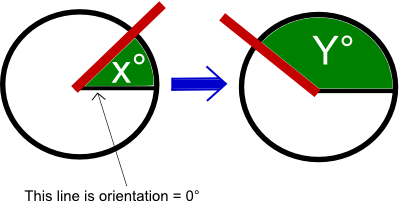Introduction
When you build some animations with WPF, Surface or JavaFX, you sometimes need to know how to evolve an angle. For example, you have the new angle (orientation) of an object and you have stored before the last measure of this orientation: how to calculate the evolution ?

A First Solution
"This is simple" will you say, just do this:
double difference = secondAngle - firstAngle;
But this snippet leads to errors. This is because the orientation value given is relative to a certain initial value, and restart to 0° if you pass the 360°. Let's give you an example: if the object was oriented at 358° and the user turns it of 5°, you will obtain a difference of (3-358=) -355° where you actually wanted to find 5....
A Better Solution
A solution I propose is to consider that the methods are called frequently enough that if the object rotates to the left or to the right. It does not have enough time to rotate more than 180° (half a tour).
Based on this, we consider that the direction of the rotation is given by the "shortest way". If it is shorter to turn to the left to go to the new angle, then we select the angle sign which tells we have turned to the left. It may be easiest to understand by looking attentively to the image above.
An image is may be better than words:

We then have this method in C#:
private double calculateDifferenceBetweenAngles(double firstAngle, double secondAngle)
{
double difference = secondAngle - firstAngle;
while (difference < -180) difference += 360;
while (difference > 180) difference -= 360;
return difference;
}
A Case of Use
When do use it? For example, when you build a carousel: the user can click on a specific item and the carousel rotates so it is in front of you. You then need to have the correct angle. I found no other way to do it.
Does someone have a better way to proceed?
CodeProject
